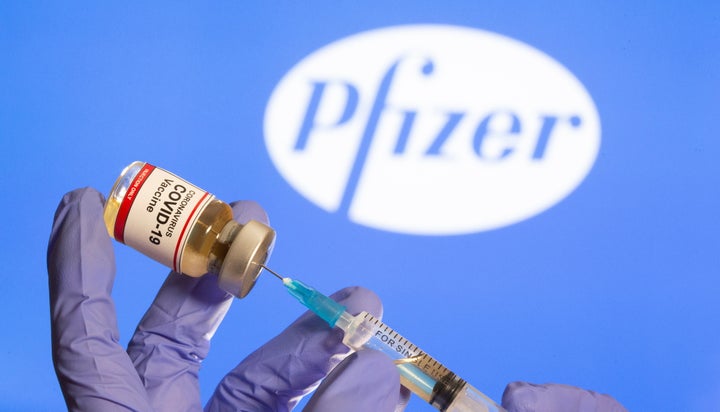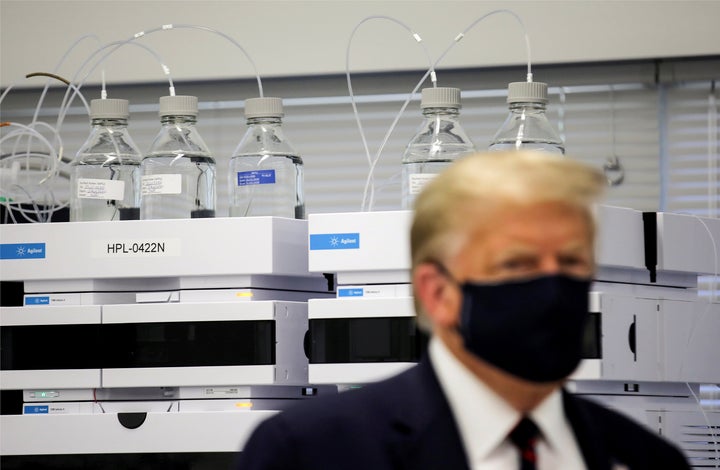The big COVID-19 news from Monday is Pfizer’s announcement that its experimental vaccine looks to be highly effective at preventing the disease, with no apparent safety problems ― although, to be clear, that’s all based on the company’s own preliminary data.
The announcement got attention around the world, sending financial markets up on hopes that a proven vaccine would soon be available. And in the U.S., it set off an immediate political controversy as the Trump administration and its critics argued over how much credit, if any, the administration’s “Warp Speed” initiative deserves for the apparent advance.
Experts, meanwhile, were quick to sound cautionary notes, including one from Pfizer itself. The findings, which come from “phase 3” trials, have not yet gotten an outside peer review.
Even if the vaccine really works as well as the preliminary Pfizer data suggests, and even if similar vaccines also in development soon show similar results, manufacturing and then distributing them will require a massive, unprecedented effort.
Still, infectious disease specialists and other experts expressed palpable excitement at the news that, so far, the vaccine has proven 90% effective. That is a lot higher than most had expected from the first-generation COVID-19 vaccines. If that number holds up and if the vaccine proves safe ― two very big ifs ― then it could be a major step toward controlling the pandemic.
“90% vaccine effectiveness is outstanding,” Preet Malani, an infectious disease specialist at the University of Michigan, told HuffPost. “We will want to see data, but this is a best-case scenario.”
“Today’s announcement makes me excited for the promise of a vaccine,” said Joshua Sharfstein, vice dean at the Johns Hopkins Bloomberg School of Public Health.
But Sharfstein, a former deputy commissioner of the U.S. Food and Drug Administration, also cautioned that “there are a number of steps still to go to realize this promise, starting with collecting more safety data and the independent review of the study results.”
Here’s some background on what the announcement says and what, maybe, it means.

Where does vaccine development stand right now?
Pfizer is partnering with a German company, BioNTech. Their vaccine candidate is one of dozens being studied by scientists across the world, and each one will be subject to review by authorities like the FDA, the European Medicines Agency and China’s medical products administration.
Drug and vaccine development follows the basic scientific method every elementary school student learns. In practice, this approach assesses a new pharmaceutical’s safety and efficacy, first in the lab and later with human test subjects. Each of these phases could effectively end the process if the results aren’t positive.
Phase 3 represents the last stage of study, during which participants are split into two groups, one that receives the vaccine in development and another that receives a placebo. The results are then compared to determine whether the novel pharmaceutical is effective against the virus and whether it’s safe.
The process typically takes years, and like all pharmaceutical research, it is marked more often by failure than success. But the progress to date on the vaccine against COVID-19 has been remarkably quick, owing in part to the urgent, global crisis and in part to scientists being familiar with other forms of coronavirus, such as SARS, which caused an epidemic in 2003.
Although Pfizer and BioNTech are the first to announce phase 3 results, AstraZeneca (which is working with the University of Oxford), Johnson & Johnson (which is working with Janssen Pharmaceuticals), and Moderna are not far behind.
Moderna is well into its phase 3 studies and has said it hopes to have enough data to apply for emergency FDA approval (which is also what Pfizer and the other vaccine-makers will be seeking) by the end of this month.
What exactly did Pfizer/BioNTech announce?
The Pfizer/BioNTech phase 3 study included 43,538 participants, some of whom received the vaccine and others the placebo. The evaluation was conducted once there were 94 confirmed cases of COVID-19 among total participants.
Researchers found that, relative to the placebo group, participants who got the full vaccination were 90% less likely to get infected.
Although Pfizer/BioNTech has its own expert panel, the results have not been subject to outside review ― a key test for any drug or vaccine. That is why scientists are so quick to sound cautionary notes.
If the 90% figure turns out to be real, that would be significantly better than the 60-70% efficacy many had hoped to achieve. And the more effective the vaccine, the fewer people will get sick ― especially if it turns out that other vaccines in development have similarly high efficacy rates.
How does the Pfizer/BioNTech vaccine actually work?
The Pfizer/BioNTech vaccine is the first in a new type that uses mRNA (short for “messenger RNA”), which occurs naturally. It’s the code, manufactured using DNA templates, that cells normally use to manufacture proteins that the body then deploys for a variety of purposes.
But the mRNA in the Pfizer/BioNTech vaccine isn’t naturally occurring. The drug manufacturers created it artificially, based on an analysis of the original COVID-19 virus in China. This new mRNA contains instructions for one of the virus proteins that form the now-familiar spikes that imaging has captured. (The “corona” in coronavirus comes from the word “crown.”)
“We will want to see data, but this is a best-case scenario.”
- Preeti Malani, University of Michigan
The Pfizer/BioNTech vaccine, like some others in development, introduces that mRNA to the body so that it gets into cells. Those cells then produce that spike protein, like they would any other protein. The immune system reacts because the protein is foreign, and “remembers” what it looks like.
Then, when the body encounters the actual COVID-19 virus, immune cells recognize the spikes and defeat the virus before it can cause a major infection.
Or, at least, that’s the hope. A new vaccine inevitably means new safety concerns ― concerns that can’t be answered until researchers get more data and regulatory agencies review it. Likewise, it’s possible the vaccine won’t prove so effective once we have more data and analysis.
What challenges remain if the data holds up?
The Pfizer/BioNTech vaccine requires two doses, delivered 21 days apart. And if it works as hoped, huge logistical challenges will remain.
Among other things, the Pfizer/BioNTech vaccine uses microscopic vessels, called lipid nanoparticles, to hold the mRNA. The vessels degrade easily, so the vaccine has to be stored in subfreezing temperatures, although Pfizer/BioNTech has said it’s working on a version that can be stored in normal freezers. Some health care providers, especially in rural areas, may not have the facilities.
Supply chain issues loom as well. Somebody has to make sure there are enough of these nanoparticles ― and, though it seems much more pedestrian, somebody has to make sure there are enough vials for delivering the injections. Distributing the vaccine and then administering it will not be easy, either.
Moderna’s vaccine, by the way, works in a similar way to the Pfizer/BioNTech. The Johnson & Johnson/Janssen Pharmaceuticals and AstraZeneca/University of Oxford vaccines use so-called adenoviruses ― which cause cold-like symptoms ― but swap in the COVID-19 protein.
“Other vaccine manufacturers will likely be sharing initial results soon, but the Pfizer announcement is a good sign for other candidate vaccines, including the Moderna vaccine which uses a similar platform of mRNA,” Malani said.

Why did this announcement happen now?
Trump allies wasted no time questioning the timing of the pharmaceutical giant’s news ― less than a week after the election ― suggesting some sort of coordinated effort to harm the president’s chances for reelection.
“Nothing nefarious about the timing of this at all right?” Donald Trump Jr. wrote in a post to Twitter, including an emoji of a face rolling its eyes.
Pfizer CEO Albert Bourla has dismissed such conspiratorial claims. In an interview with CNN on Monday, he said that the company announcement was made as soon as the scientific data showed the vaccine’s effectiveness.
“We announced it the moment we learned about it, and I said multiple times the election for us is an artificial timeline,” Bourla said. “This is when science brought it to us.”
What role did the Trump administration play?
The Trump administration’s push for public-private partnerships to expedite a coronavirus vaccine, dubbed “Operation Warp Speed,” has dominated the government’s otherwise lethargic response to the coronavirus pandemic.
Vice President Mike Pence joined others Monday in crediting Operation Warp Speed for Pfizer’s early vaccine success.
Just what role Operation Warp Speed actually played in its development is less clear.
Pfizer did not take federal dollars for research and development of its COVID-19 vaccine candidate. On the other hand, the company did strike a deal with the federal government to provide 100 million doses for roughly $2 billion, although Pfizer gets the money only if the FDA approves the vaccine and only after those first 100 million doses are delivered.
Pfizer and BioNTech have said they can manufacture as many 100 million doses by the end of the year and as many as 1.3 billion by the end of 2021. (That is for total worldwide distribution; Pfizer isn’t guaranteeing 100 million for the U.S. by year’s end.)
In making its announcement, Pfizer distanced itself from the Trump administration effort. “We were never part of the Warp Speed,” Kathrin Jansen, the head of vaccine development at Pfizer, told The New York Times. “We have never taken any money from the U.S. government, or from anyone.”
But in a subsequent statement, the company clarified that it is “one of various vaccine manufacturers participating in Operation Warp Speed as a supplier of a potential COVID-19 vaccine.”
On Twitter, Sen. Chris Murphy (D-Conn.) said that the Trump administration “shouldn’t take the credit for the Pfizer/BioNTech progress, but it’s not fair to suggest that this was simply a ‘private sector’ effort.”
The Department of Health and Human Services “did a $2 billion deal with Pfizer to guarantee a market for the vaccine, making Pfizer’s [research and development spending] viable,” Murphy wrote. “Classic public/private partnership.”
Pfizer’s German partner, BioNTech, did accept research funding from the German government.
The vaccine, if approved, is expected to be free for U.S. citizens.
- Here’s the latest science on COVID antibodies.
- How does the coronavirus spread differently than the flu?
- What does the new CDC definition of a COVID-19 “close contact” mean for you?
- Is it safe to see grandparents for the holidays?
- Therapists predict how this year will shape our mental health.
